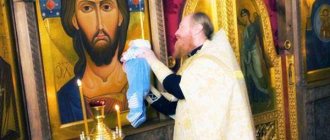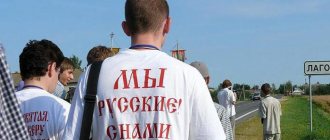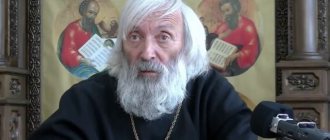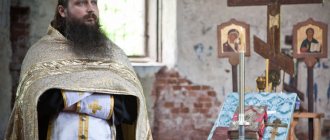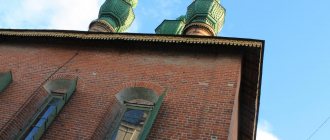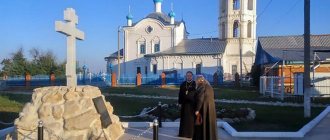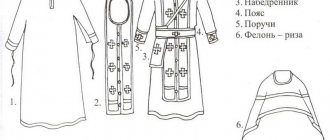Military priests in battle formations
Believers call Easter the celebration of all celebrations. For them, the Resurrection of Christ is the main holiday of the Orthodox calendar. For the sixth time in a row in its modern history, the Russian army celebrates Easter, overshadowed by military priests who appeared in units and formations after a ninety-year break.
At the origins of tradition
The idea of reviving the institution of military priests in the Russian army arose among the hierarchs of the Russian Orthodox Church (ROC) back in the mid-nineties. It did not receive much development, but secular leaders generally assessed the initiative of the Russian Orthodox Church positively. The favorable attitude of society towards church rituals was also influenced by the fact that after the liquidation of the staff of political workers, the education of personnel lost a clear ideological core. The post-communist elite was never able to formulate a new, bright national idea. Her search led many to a long-familiar religious perception of life.
The initiative of the Russian Orthodox Church floundered mainly because the main thing in this story was missing - the military priests themselves. The priest of an ordinary parish was not suitable for the role of, for example, the confessor of desperate paratroopers. Here there must be a person from their midst, respected not only for the wisdom of the religious sacrament, but also for military valor, at least for the obvious readiness for a feat of arms.
This is how the military priest Cyprian-Peresvet became. He himself formulated his biography as follows: first he was a warrior, then a cripple, then he became a priest, then a military priest. However, Cyprian dates his life only from 1991, when he took monastic vows in Suzdal. Three years later he was ordained a priest. The Siberian Cossacks, reviving the familiar Yenisei district, elected Cyprian as a military priest. The story of this ascetic of God deserves a separate detailed story. He went through both Chechen wars, was captured by Khattab, stood at the firing line, and survived his wounds. It was in Chechnya that the soldiers of the Sofrino brigade named Cyprian Peresvet for his courage and military patience. He also had his own call sign “YAK-15” so that the soldiers would know: the priest was next to them. Supports them with soul and prayer. Chechen comrades called Cyprian-Peresvet their Brother, the Sofrintsy called Batya.
After the war, in June 2005 in St. Petersburg, Cyprian will take monastic vows into the Great Schema, becoming the elder schema-abbot Isaac, but in the memory of Russian soldiers he will remain the first military priest of modern times.
And before him - the great and blessed history of the Russian military clergy. For me and, probably, for the Sofrintsy, it begins in 1380, when the Monk Sergius, abbot of the Russian land and the Wonderworker of Radonezh, blessed Prince Dmitry for the battle for the liberation of Rus' from the Tatar yoke. He gave him his monks - Rodion Oslyabya and Alexander Peresvet - to help him. It is Peresvet who will then go out onto the Kulikovo field to duel with the Tatar hero Chelubey. The battle will begin with their mortal combat. The Russian army will defeat Mamai's horde. People will associate this victory with the blessing of St. Sergius. The monk Peresvet, who fell in single combat, will be canonized. And we will call the day of the Battle of Kulikovo - September 21 (September 8 according to the Julian calendar) the Day of Military Glory of Russia.
There are more than six centuries between the two Peresvets. This time contained a lot - arduous service to God and the Fatherland, pastoral exploits, grandiose battles and great upheavals.
According to military regulations
Like everything else in the Russian army, military spiritual service first acquired its organizational structure in the Military Regulations of Peter I of 1716. The reformer emperor considered it necessary to have a priest in every regiment, on every ship. The naval clergy were predominantly hieromonks. They were headed by the chief hieromonk of the fleet. The clergy of the ground forces were subordinate to the field chief priest of the active army, and in peacetime - to the bishop of the diocese on whose territory the regiment was stationed.
By the end of the century, Catherine II placed a single chief priest of the army and navy at the head of the military and naval clergy. It was autonomous from the Synod, had the right of direct reporting to the Empress and the right of direct communication with the diocesan hierarchs. A regular salary was established for the military clergy. After twenty years of service, the priest was awarded a pension.
The structure received a military-style finished look and logical subordination, but was corrected over the course of a whole century. Thus, in June 1890, Emperor Alexander III approved the Regulations on the management of churches and clergy of the military and naval departments. Established the title of “Protopresbyter of the Military and Naval Clergy.” All churches of regiments, fortresses, military hospitals and educational institutions were placed under his jurisdiction (except for Siberia, in which “due to the range of distances” the military clergy was subordinate to the diocesan bishops.)
The economy turned out to be solid. The department of the protopresbyter of the military and naval clergy included 12 cathedrals, 3 house churches, 806 regimental churches, 12 serfs, 24 hospital churches, 10 prison churches, 6 port churches, 34 churches at various institutions (407 churches in total), 106 archpriests, 337 priests, 2 protodeacon, 55 deacons, 68 psalmists (total - 569 clergy). The Office of the Protopresbyter published its own magazine, “Bulletin of the Military Clergy.”
The highest Regulations determined the service rights of the military clergy and maintenance salaries. The chief priest (protopresbyter) was equated to a lieutenant general, the chief priest of the General Staff, Guards or Grenadier Corps - to a major general, the archpriest - to a colonel, the rector of a military cathedral or temple, as well as the divisional dean - to a lieutenant colonel. The regimental priest (equal to the captain) received almost the full captain's ration: a salary of 366 rubles per year, the same amount of canteens, bonuses were provided for length of service, reaching (for 20 years of service) up to half the established salary. Equal military pay was observed for all clergy ranks.
Dry statistics give only a general idea of clergy in the Russian army. Life brings its bright colors into this picture. Between the two Peresvets there were wars, difficult battles. There were also their Heroes. Here is priest Vasily Vasilkovsky. His feat will be described in order for the Russian army No. 53 dated March 12, 1813 by Commander-in-Chief M.I. Kutuzov: “The 19th Jaeger Regiment, priest Vasilkovsky in the battle of Maly Yaroslavets, being in front of the riflemen with a cross, prudent instructions and personal With courage he encouraged the lower ranks to fight without fear for the Faith, the Tsar and the Fatherland, and was cruelly wounded in the head by a bullet. In the battle of Vitebsk he showed the same courage, where he received a bullet wound in the leg. I presented the initial testimony of such excellent actions, fearless in battle, and zealous service of Vasilkovsky to the Emperor, and His Majesty deigned to award him the Order of the Holy Great Martyr and Victorious George, 4th class.”
This was the first time in history that a military priest was awarded the Order of St. George. Father Vasily will be awarded the order on March 17, 1813. In the fall of the same year (November 24), he died on a trip abroad from his wounds. Vasily Vasilkovsky was only 35 years old.
Let's jump a century to another great war - the First World War. This is what the famous Russian military leader, General A.A., wrote about that time. Brusilov: “In those terrible counterattacks, black figures flashed among the soldiers’ tunics - regimental priests, tucking up their cassocks, walked with the soldiers in rough boots, encouraging the timid with simple evangelical words and behavior... They remained there forever, in the fields of Galicia, without being separated from their flock.”
For heroism shown during the First World War, about 2,500 military priests will be awarded state awards and will be presented with 227 golden pectoral crosses on the St. George Ribbon. The Order of St. George will be awarded to 11 people (four posthumously).
The Institute of Military and Naval Clergy in the Russian Army was liquidated by order of the People's Commissariat for Military Affairs on January 16, 1918. 3,700 priests will be fired from the army. Many are then repressed as class alien elements...
Crosses on buttonholes
The efforts of the Church yielded results by the end of the 2000s. Sociological surveys initiated by priests in 2008-2009 showed that the number of believers in the army reaches 70 percent of the personnel. The then Russian President Dmitry Medvedev was informed about this. With his assignment to the military department, a new time of spiritual service in the Russian army begins. The President signed this order on July 21, 2009. He obliged the Minister of Defense to make the necessary decisions aimed at introducing the institution of military clergy in the Russian Armed Forces.
Carrying out the president's instructions, the military will not copy the structures that existed in the tsarist army. They will start by creating a Directorate for working with religious servicemen within the Main Directorate of the Armed Forces of the Russian Federation for working with personnel. Its staff will include 242 positions of assistant commanders (chiefs) for work with religious military personnel, replaced by clergy of traditional religious associations of Russia. This will happen in January 2010.
For five years, it was not possible to fill all the proposed vacancies. Religious organizations even submitted an abundance of their candidates to the Department of Defense. But the bar for the military's demands turned out to be high. So far they have accepted only 132 clergymen to work in the troops on a regular basis - 129 Orthodox, two Muslims and one Buddhist. (I note, by the way, that in the army of the Russian Empire they were also attentive to believers of all faiths. Catholic soldiers were supervised by several hundred chaplains. Mullahs served in national-territorial formations, such as the “Wild Division.” Jews were allowed to attend territorial synagogues.)
High demands for priestly service probably grew out of the best examples of spiritual shepherding in the Russian army. Maybe even from those that I remembered today. At least the priests are being prepared for serious tests. Their robes will no longer unmask their priests, as happened in the battle formations of the unforgettable Brusilov breakthrough. The Ministry of Defense, together with the Synodal Department of the Moscow Patriarchate for interaction with the Armed Forces and Law Enforcement Agencies, has developed “Rules for wearing uniforms by military clergy.” They were approved by Patriarch Kirill.
According to the rules, military chaplains “when organizing work with religious military personnel in conditions of military operations, during a state of emergency, liquidation of accidents, hazardous natural phenomena, catastrophes, natural and other disasters, during exercises, classes, combat duty (combat service)” will wear not church vestments, but a field military uniform. Unlike the uniform of military personnel, it does not provide shoulder straps, sleeve and breastplates for the corresponding branch of the military. Only the buttonholes will be decorated with dark-colored Orthodox crosses of the established pattern. When performing a divine service in the field, the priest must wear an epitrachelion, braces and a priestly cross over his uniform.
The basis for spiritual work in the troops and navy is also being seriously updated. Today, only in the territories under the jurisdiction of the Ministry of Defense there are more than 160 Orthodox churches and chapels. Military churches are being built in Severomorsk and Gadzhievo (Northern Fleet), at the air base in Kant (Kyrgyzstan), and in other garrisons. The Church of St. Archangel Michael in Sevastopol, the building of which was previously used as a branch of the Black Sea Fleet Museum, has again become a military temple. Defense Minister S.K. Shoigu decided to allocate rooms for prayer rooms in all formations and on rank 1 ships.
...A new history is being written for military spiritual service. What will it be like? Definitely worthy! This is obligated by centuries-old traditions that have melted into the national character - the heroism, fortitude and courage of Russian soldiers, the diligence, patience and self-sacrifice of military priests. In the meantime, the great Easter holiday is celebrated in military churches, and the collective communion of soldiers is like a new step in their readiness to serve the Fatherland, the World and God.
Antiquity: fortune telling and sacrifices
Warriors have been turning to cult representatives, perhaps, since the birth of human civilization. The armies of ancient Egypt and Babylon asked the gods for victory. In the ancient Roman Empire, several religious ministers were assigned to the headquarters of each legion. They performed rituals and made sacrifices. Before every major event, including before battles, the priests asked the gods whether the Roman army would be lucky or if the gods had turned their backs on it.
Ritual in honor of the god of war (photo source)
If the signs sent down from above were considered unfavorable, then the battle could be postponed. The moral and psychological spirit of the soldiers, confident of victory, was more important than favorable conditions for battle. But the Druids, representatives of the cults of the old enemies of Rome - the Gauls, rejected violence and did not take part in the military affairs of their fellow tribesmen.
Of course, priests found themselves among the soldiers from the very beginning of the spread of faith in Christ. Most of the soldiers in the army of the first Christian emperor Constantine were Christians. In the battle for Rome against Maxentius, Constantine led legions bearing the image of a cross on their shield. A little time passed, the empire fell. The Dark Ages have arrived. In Europe, paganism flourished on the outskirts, and Christianity prevailed in the richest and most populous countries.
Literature
- Complete collection of decrees and orders for the department of the Orthodox Confession of the Russian Empire: The reign of Emperor Nicholas I
, Pg., 1915, vol. 1. - Regulations on the management of churches and clergy of the military.
and pestilence departments , St. Petersburg, 1890. - Orders for the military department
, St. Petersburg, 1890, No. 208. - Orders of the People's Commissariat for Military Affairs
, Pg., 1918, No. 39. - SVP.
1859 , St. Petersburg, 1859, part I, book. I. - Nevzorov N., Historical sketch of the management of the clergy of the military department in Russia
, St. Petersburg, 1875. - Barsov T.V., On the management of the Russian military clergy
, St. Petersburg, 1879. - Barsov T.V., New regulations on the management of churches and clergy of the military and naval departments
, St. Petersburg, 1893. - Bogolyubov A., Essay on the history of the management of the military and naval clergy in the biographies of its main priests from 1800 to 1901
, St. Petersburg, 1901. - “Administration of Churches and Orthodox Clergy of the War Department: Historical Sketch,” Centenary of the War Department.
1802-1902 , St. Petersburg, 1902, vol. 13. - Laskeev F., To the 50th anniversary of the priesthood of Protopresbyter of the military and naval clergy A. A. Zhelobovsky
, St. Petersburg, 1909. - Tsitovich G. A., Temples of the Army and Navy: Historical and statistical description
, Pyatigorsk, 1913. - Smirnov A.V., History of the naval clergy
, St. Petersburg, 1914 - Shavelsky G.I., protopres., Memoirs of the last protopresbyter of the army and navy
, New York, 1954 (reprint M., 1996), vol. 1-2. - History of the naval clergy: Collection of articles
, M., 1993. - Orthodoxy, the army and navy of Russia: Collection of articles
, St. Petersburg, 1996. - Baibakov A.V., Orthodox clergy of the Russian army and navy: The second half of the 19th - early 20th centuries
, M., 1997. - Nechaeva M. Yu., comp., Christian periodicals of Russia at the end of the 18th-20th centuries: Catalog of publications
, Ekaterinburg, 2000. - Statehood of Russia: Dictionary-reference book
, M., 2001. book. 4, p. 291-292, 331.
Inventing prayers
The institution of military clergy also gave rise to oddities. In European countries and the United States, during the secularization of society in the 19th century, military chaplains serving in a specific military environment often adopted the habits and customs of the officers around them. So at times it was not entirely clear whether that gentleman over there, who readily drinks and swears, could be called a holy father.
(Photo source)
A parody of such a chaplain was made by J. Hasek in the image of Feldkurat Otto Katz.
His sermons were unusually fascinating, witty and brought excitement to the garrison boredom. He so amusingly babbled his tongue about the infinite mercy of God in order to support the “fallen in spirit” and wicked prisoners, swore so deliciously from the pulpit, so selflessly sang at the altar his “Get out, the service is over.” He conducted worship in a very original way. He changed the entire order of the Holy Mass, and when he was very drunk, he invented new prayers, a new mass, his own ritual - in a word, something that no one had ever seen before.
But such chaplains were more an object of military folklore than heroes of real life. History knows many deeds and heroic deeds that military priests performed. However, this is a completely different story.
Story
Badge of the Archdiocese of US Navy Chaplains.
Badge of the Chaplaincy Department of the UGCC (Ukraine) 2011. The origin of the term “chaplain” is associated with the name of St. Martin of Tours. According to legend, one day the saint met a beggar, and the beggar began to beg him for the saint to give him some of his clothes to cover his rags. Martin cut his cloak into two parts and gave one to the person who asked. The next night the bishop had a dream that that day Jesus Christ appeared before him in the form of a beggar. The second part of the cloak of St. Martin of Tours became a relic of the Merovingians and was called a “capa” (to this day the capa is part of the vestments of Catholic priests). The kings of the Franks took the capa on military campaigns, where it was supposed to protect them from danger. The priest traveling with the army eventually began to be called a chaplain, that is, “guardian of the cap.”
Among Catholics, a chaplain (late Latin capellanus, clericus de capella) in the Middle Ages (the first evidence of the term dates back to 781) was a clergyman belonging to a court chapel composed of aristocrats and church hierarchs, later, until the 17th century, a “household” priest , who combined church duties (leadership of “private” worship) with the duties of a secretary. At large medieval courts, over time, a high chaplain (archicapellanus, in the position of bishop or abbot) emerged, whose duties could include not only worship and management of the affairs of the patron, but also his official representation abroad (like modern diplomats). As the court chapels expanded and grew in status, a division of responsibilities arose; Thus, in the late Middle Ages (the first evidence is in the 30s of the 14th century), the leadership of the musical accompaniment of worship was separated from the chaplain and entrusted to the “master of the chapel” (magister capellae), the bandmaster, administratively subordinate to the (arch)chaplain. A separate position was occupied (also subordinate to the supreme chaplain) by the head of the chancellery, the chancellor. Over time, the court chancellery, as well as the musical court chapel, acquired an independent status. Eventually (from about the 18th century), the chaplain's duties were reduced to worship. According to modern Canon Law (CCC 564), a chaplain is “a priest entrusted with the permanent pastoral care of any community or special group of Christians, carried out according to the norms of universal and particular law”[1].
Middle Ages: Pious Christian Warriors
Christian priests saw medieval armies as one of the best objects for preaching. Moreover, after the baptism of the barbarian princes and kings, their warriors still remained pagans at heart. This should not have been allowed to happen. In addition, the warriors quickly turned into counts, barons and boyars - and, having joined the new faith, they could carry its light to their own lands.
Priests continued to accompany the army on campaigns even after the spread of Christianity to all corners of Europe. A duke or prince, going to war, took with him several clergy, who conducted church services for the soldiers.
The state of affairs changed with the beginning of the era of the Crusades. Firstly, the army was now accompanied by official envoys of the Pope. And secondly, spiritual knightly orders appeared, whose warriors were monks. Some of them were ordained priests and could with full right perform all Christian rites.
Notes
- A. Murray
. Chaplain // Catholic Encyclopedia. T.2. - M., 2005. - column 779. - ↑ 1 2 Leontyeva Tatyana Gennadievna.
Orthodox clergy during the First World War // Russia and the modern world. — 2014. — No. 2 (83). — P. 104—119. — ISSN 1726-5223. - Airborne Forces priests will be trained in the use of an airborne Orthodox church (unspecified)
. - Religion News (English). www.ng.ru. Date accessed: December 22, 2018.
- Why building Falcon Circle was 'right thing to do' > United States Air Force Academy > Display (undefined)
. web.archive.org (May 20, 2017). Date accessed: December 22, 2018. - National Native American Veterans Memorial. National Native American Veterans Memorial. Date accessed: December 22, 2018.
- MCCAIN STATEMENT ON THE ESTABLISHMENT OF THE NATIONAL NATIVE AMERICAN VETERANS' MEMORIAL - Speeches - United States Senator John McCain (unspecified)
(inaccessible link). www.mccain.senate.gov. Date accessed: December 22, 2021. Archived December 23, 2021. - Banerjee, Neela
.
Use of Wiccan Symbol on Veterans' Headstones Is Approved, The New York Times
(24 April 2007). Retrieved December 22, 2021.
